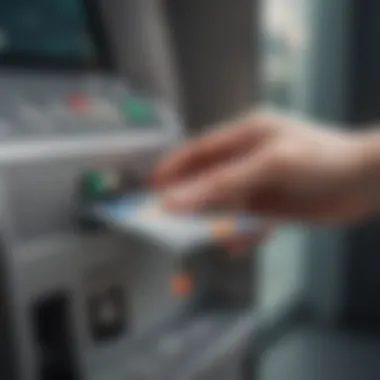Understanding Prepaid Cards: ATM Usage Insights


Intro
Prepaid cards have become increasingly popular in recent years, particularly for their ease of use at Automated Teller Machines (ATMs). These financial tools allow users to load a specific amount of money onto the card and use it for various transactions, including cash withdrawals, purchases, and online payments. Understanding how prepaid cards function at ATMs can empower users to make informed financial decisions.
This article aims to delve into the mechanics of these cards, the benefits they offer, and the limitations that often accompany their use. With a focus on security precautions and alternative options, readers can develop a well-rounded perspective on how to utilize prepaid cards more effectively while minimizing risks.
Fundamental Terms
Before diving into the specific functions of prepaid cards at ATMs, it is crucial to understand some fundamental concepts. Recognizing these terminologies aids in making better financial choices and navigating the broader landscape of prepaid cards.
Prepaid Card
A prepaid card is a financial instrument that requires the user to load funds onto it before it can be used. These cards are not linked to a bank account and function similarly to debit or credit cards, allowing transactions until the balance reaches zero.
ATM
An Automated Teller Machine is a computerized device that allows users to perform basic banking transactions, such as withdrawing cash, without the need for direct contact with a human teller.
Deposit and Withdrawal
These are essential activities performed at ATMs. A deposit adds funds to an account, while a withdrawal removes funds. With prepaid cards, the withdrawal process is particularly important as it directly impacts available balance.
Compatibility
Not all ATMs are compatible with prepaid cards. It is important to check if a specific ATM accepts prepaid cards, which may vary based on the issuing bank or network. This can affect accessibility and convenience for users.
Understanding these terms forms the bedrock of navigating the world of prepaid cards and their use at ATMs. It leads to better decision-making and preparedness when dealing with various financial tools.
Advantages of Using Prepaid Cards at ATMs
Using prepaid cards at ATMs has numerous benefits. Here are some key advantages:
- Budget Management: Prepaid cards help users keep track of their spending. Since funds need to be loaded in advance, they can prevent overspending, making them ideal for budgeting.
- No Credit Checks: Obtaining a prepaid card typically does not require credit checks. This makes them accessible to a broader range of users, including those with limited credit history.
- Security: Users can load only a limited amount of money onto their prepaid cards. This limits exposure to loss or theft compared to having large amounts of cash or even a connected bank account.
"Prepaid cards can offer a thoughtful approach to managing personal finances while ensuring that the user maintains control over their budget."
Limitations of Prepaid Cards at ATMs
While prepaid cards come with benefits, they are not without limitations. Understanding these can prevent surprises and mismanagement:
- Limited Funds: Once the balance is depleted, no further transactions can occur until the user adds more funds.
- Fees: Some cards may have associated fees for ATM withdrawals or reloading funds. Users should be aware of these potential costs.
- Acceptance Issues: Not all ATMs accept all prepaid cards, which can limit the locations where funds can be accessed.
Security Considerations
When using prepaid cards at ATMs, security is paramount. Here are some precautions to consider:
- Always monitor your balance and transactions regularly.
- Avoid sharing card details with others.
- Use ATMs in well-lit, secure areas to mitigate risk of theft or fraud.
These insights can aid users in engaging with prepaid cards thoughtfully.
Culmination
Prelude to Prepaid Cards
Prepaid cards have gained popularity as flexible financial tools that allow users to access funds without a bank account. These cards function like traditional debit cards but differ significantly in their funding mechanism. Understanding prepaid cards is vital in navigating modern payment methods and utilizing their full potential.
Many consumers appreciate the control that prepaid cards provide. Since users can only spend the amount loaded onto the card, they offer a straightforward way to manage budgets effectively. Moreover, prepaid cards are widely accepted at various merchants and can also be utilized at ATMs for cash withdrawals.


In the context of this article, we will explore the various aspects of prepaid cards, including their definition, types, and specific applications at ATMs. This knowledge will empower both beginners and experienced investors to make informed decisions about their financial arrangements.
Definition of Prepaid Cards
A prepaid card is a payment card that has a specific amount of money loaded onto it. Unlike debit cards linked to bank accounts or credit cards that extend a line of credit, prepaid cards require users to deposit funds before using them. This ensures that spending remains within set limits. Prepaid cards can be used for any transaction that accepts cards, making them a practical option for many consumers.
Types of Prepaid Cards
Prepaid cards come in two main varieties: closed-loop cards and open-loop cards. Understanding the distinctions between these can help users select the right option for their needs.
Closed-loop cards
Closed-loop cards are designed to be used only within a specific network of merchants. For example, a retailer might offer a prepaid card that can only be used in its own stores or a select group of affiliated locations. This limitation makes closed-loop cards particularly advantageous for budget management, as they can encourage users to limit spending to specific categories or brands. They often come with rewards or discounts for using them at those designated locations, adding an incentive for consumers.
However, the major disadvantage of closed-loop cards is their lack of versatility. Users cannot withdraw cash or use the card outside of its dedicated merchant network. Therefore, while they suit certain shopping habits, they might not be suitable for individuals seeking broad acceptance for their spending methods.
Open-loop cards
Open-loop cards, in contrast, provide users with greater flexibility. They can be used at nearly any retailer that accepts major card networks such as Visa or Mastercard. This characteristic broadens their appeal, especially for those who want convenient access to funds without the limitations of specific merchants. Open-loop cards often allow users to withdraw cash at ATMs, making them more versatile for various financial needs.
Nonetheless, open-loop cards typically do not offer the same incentives as closed-loop cards. Since they are more widely used, users may miss out on loyalty programs or discounts specifically tied to closed systems. Additionally, fees for open-loop cards can vary based on the issuing entity, which may not be as transparent. Choosing between these options requires careful consideration of spending habits and financial objectives.
Functionality of ATMs
The functionality of Automated Teller Machines (ATMs) is a crucial element when considering how prepaid cards interact with these machines. Understanding the operational framework of ATMs provides insight into the convenience and flexibility that prepaid card users can enjoy. At its core, ATMs serve as gateways for various banking transactions outside the conventional banking environment. By offering simplified access to funds, they have fundamentally transformed personal finance management.
How ATMs Operate
ATMs function through a series of processes that connect physical machines to banks and financial networks. When a user inserts a card into an ATM, the machine communicates with the bank to verify the card details. After the verification, the user can select from various transaction types. This interaction occurs in real-time, ensuring immediate access to account information. Key components include the card reader, keypad, screen, and cash dispensing mechanism. Each component works seamlessly to provide the user a smooth experience. The interface must be user-friendly and capable of guiding various levels of financial literacy.
Types of Transactions Available at ATMs
ATMs accommodate multiple transaction types, making them versatile financial tools. Recognizing the types of transactions offered helps to show how prepaid cards can be effectively utilized.
Cash withdrawals
Cash withdrawals represent one of the most common transactions performed at ATMs. This allows users to access funds directly, which is invaluable for various everyday needs. One key characteristic of cash withdrawal is the immediate availability of funds. Once processed, the cash is dispensed without delay. This transactional speed is a significant draw for users who require quick, on-the-spot access to their finances. However, users should note that many prepaid cards have withdrawal limits that may restrict the amount that can be accessed at once.
Balance inquiries
Balance inquiries provide an essential service, allowing users to check their account status conveniently. This aspect is particularly helpful for those managing multiple financial tools. The primary benefit of checking one’s balance at an ATM is the real-time reflection of funds available. This live information aids in decision-making regarding spending and withdrawals. However, one downside is the potential for fees associated with this inquiry, depending on the ATM’s operator and the type of prepaid card.
Deposits
Deposits at ATMs offer another vital transaction type. This functionality enables users to add funds without visiting a bank branch. It is convenient for cardholders who need to increase their balance quickly. Many ATMs are equipped to accept cash and checks, streamlining the process for depositing money. Though advantageous, users must be aware of potential holds that may apply to deposited checks. Each ATM may also impose different limits on the amounts that can be deposited, which should be considered in financial planning.
ATMs enhance accessibility to funds and broaden the usability range of prepaid cards, making them significant enablers of financial autonomy.
Using Prepaid Cards at ATMs
The role of prepaid cards at ATMs goes beyond basic cash withdrawals. Understanding this aspect of prepaid cards provides valuable insights into their utility, functionality, and limitations. Prepaid cards offer an accessible way to manage funds without linking to a bank account. This feature appeals to many users, particularly those who want to budget effectively. Additionally, the convenience of using prepaid cards at ATMs makes it easier to access funds when needed.
Compatibility with ATMs
Prepaid cards are generally compatible with most ATMs. This compatibility allows users to perform various transactions, such as cash withdrawals and balance inquiries. The key lies in choosing an ATM that accepts the specific prepaid card. Some financial institutions have restrictions, but many ATMs support a range of brands, including Visa and Mastercard. When approaching an ATM, users should verify that the card logo is displayed on the ATM screen before proceeding.
Steps to Withdraw Cash


Withdrawing cash using a prepaid card is a straightforward process. Here are the key steps:
- Insert the Card: Place the prepaid card into the ATM slot. Ensure it is inserted correctly.
- Select Language: Choose a preferred language from the options provided, if necessary.
- Enter PIN: Input the Personal Identification Number (PIN) associated with the prepaid card. This is crucial for security.
- Choose Transaction: Select "Withdraw Cash" from the available options.
- Enter Amount: Input the amount of cash to withdraw. Ensure it does not exceed balance or limits set by the card provider.
- Collect Cash and Card: Once the transaction is complete, collect the cash and the card.
Following these steps can ensure a smooth transaction at ATMs.
Limitations of Prepaid Card Usage
Withdrawal limits
Withdrawal limits are a significant consideration when using prepaid cards at ATMs. Most prepaid cards cap the amount that can be withdrawn per transaction or per day. This limitation serves as a protective measure to prevent unauthorized access to funds. While some users may find these limits restrictive, they also encourage responsible usage. Managing cash flow within set boundaries is a beneficial aspect that promotes financial discipline.
Vendor restrictions
Vendor restrictions can play a role in the usability of prepaid cards at ATMs. Certain retailers or service providers may have specific limitations on the types of transactions that can be performed. For instance, some ATMs might charge fees for using prepaid cards, depending on the issuing bank's policies. Understanding these restrictions is crucial for users to maximize their card's potential. It ensures that users are aware of any additional costs or limitations connected to their prepaid card usage.
"Using prepaid cards offers a measure of financial control that appeals to many consumers. However, being aware of its limitations can enhance the user experience."
Benefits of Using Prepaid Cards at ATMs
Prepaid cards have become a popular alternative for managing personal finances. They offer several advantages that cater to a wide range of users. Understanding these benefits can help individuals make informed financial decisions. This section delves into two primary advantages of using prepaid cards at ATMs: the convenience of accessing funds and the prevention of debt accumulation.
Convenience of Accessing Funds
One of the most significant benefits of prepaid cards is the convenience they provide when accessing funds. Users can withdraw cash easily from ATMs. This accessibility makes it simpler to handle daily expenses. Forgetting to carry cash is a common issue, and prepaid cards solve this problem effectively.
Prepaid cards are widely accepted at many ATM locations. Users find it easier to locate ATMs that support their prepaid cards, often avoiding fees imposed by third-party ATM operators. In addition, the withdrawal process is typically straightforward. Users insert the card, enter their PIN, and select the amount they wish to withdraw.
Moreover, prepaid cards can be loaded with specific amounts according to the user's need. This feature allows individuals to budget their spending more effectively. They can only spend what they have preloaded onto the card, reducing the risk of overspending. This ensures that users remain vigilant about their financial habits.
Prevention of Debt Accumulation
Another essential aspect of using prepaid cards is their role in preventing debt accumulation. Unlike traditional credit cards, prepaid cards do not allow for borrowing money. This limitation means that users cannot spend more than the funds available on their cards. This aspect can be quite beneficial, especially for individuals who struggle with impulse spending or managing credit lines.
By using a prepaid card, users must assess their financial situation before spending. This prudent approach encourages better financial practices. People can monitor their spending habits more effectively since they essentially operate within a fixed budget.
Additionally, the lack of credit checks for prepaid card applications makes them accessible to a broader audience. Individuals with poor credit history can utilize them without the fear of further damaging their financial standing. This feature is crucial for promoting a more responsible use of finances, as individuals learn to manage their money wisely rather than rely on borrowing.
"Prepaid cards offer a distinct method to control spending and access cash, presenting both convenience and limits on debt."
In summary, the benefits of using prepaid cards at ATMs extend beyond convenience. They promote better financial habits by preventing the accumulation of unnecessary debt. By understanding these advantages, users can make informed decisions regarding their financial tools.
Security Considerations
In the sphere of financial transactions, especially with prepaid cards utilized at ATMs, security considerations hold paramount significance. It is vital to understand the vulnerabilities and protective measures that can safeguard users against potential threats. Addressing these security aspects can enhance user confidence, while also promoting responsible financial behavior. Given the rise of digital banking, understanding these elements is essential for anyone considering the use of prepaid cards.
Potential Risks of Using Prepaid Cards
Fraud alerts
Fraud alerts are crucial mechanisms designed to protect cardholders from unauthorized activities. These alerts notify users when suspicious transactions occur, such as withdrawals that deviate from normal spending patterns. This feature acts as an early warning system, potentially preventing significant financial loss. The appealing aspect of fraud alerts lies in their proactive stance. By providing immediate notifications, users have the opportunity to respond quickly, whether by freezing their card or reporting the fraudulent activity.
Moreover, many prepaid card issuers implement systems that analyze transaction habits. If a transaction takes place in a location or for an amount that falls outside of typical spending behavior, the fraud alert will trigger. This not only serves to protect individuals but also strengthens the overall integrity of the prepaid card system. However, users should ensure that their contact information is updated with the card issuer to maintain the efficiency of this feature.
Theft
Theft poses a tangible risk for users of prepaid cards. Unlike traditional bank accounts, which may offer greater fraud protection, prepaid cards often hold limited liability terms. In the event of a stolen card or compromised account information, users may face challenges recovering lost funds. Furthermore, the lack of comprehensive backup systems can increase susceptibility to theft.


A key characteristic of theft in this context is the physical nature of prepaid cards. Users must be mindful of where and how they store their cards. If a card is lost or stolen, it is essential to act swiftly to report the incident to the card issuer. In some cases, immediate reporting can result in better recovery chances. However, the limitation lies in the fact that many prepaid cards lack robust fraud prevention mechanisms, meaning they may provide less security compared to debit or credit cards.
Best Practices for Security
Monitoring transactions
Monitoring transactions on prepaid cards is an act of diligence that can greatly contribute to financial security. Regularly checking transactions helps users identify any activity that appears unfamiliar or suspicious. This practice not only helps in spotting potential fraud but also aids in budgeting and keeping track of spending habits.
The unique feature of transaction monitoring is the accessibility it provides for cardholders. Most prepaid cards come with online platforms or apps that allow users to view their transaction history in real time. While this feature is common, diligence is key. Users should make it a habit to log into their accounts frequently and verify transactions, thereby reinforcing their own financial security.
Using secure ATMs
Using secure ATMs is another critical preventive measure. Not all ATMs offer the same level of security; hence, it is prudent to choose machines in well-lit, public areas that are maintained by reputable banks. This reduces the likelihood of encountering skimming devices that capture card details.
Moreover, the main advantage of using secure ATMs is the additional layer of protection they provide against potential theft or fraud. Vigilance should be practiced here as well; users should inspect the ATM for any unusual attachments before inserting their cards. In addition, it is advisable to avoid ATMs in isolated locations, especially during odd hours, as they can often be targets for criminal activities. Thus, the careful selection of ATMs enhances the overall safety of transactions made using prepaid cards.
"Understanding the security landscape is essential for making informed decisions regarding financial tools."
In summary, security considerations are a multifaceted aspect of using prepaid cards at ATMs. Users must remain vigilant about risks such as fraud and theft, while also adopting best practices like monitoring transactions and utilizing secure ATMs. These elements work together to form a stronger defense against financial threats.
Alternatives to Prepaid Cards at ATMs
Exploring alternatives to prepaid cards at ATMs is essential for individuals looking to manage their finances. While prepaid cards offer specific benefits, they may not suit everyone’s needs. Consumers should consider various options, each coming with unique features, advantages, and potential drawbacks.
Debit Cards
Debit cards are a prevalent alternative to prepaid cards, linked directly to a checking account. When using a debit card, withdrawals at ATMs draw from available funds rather than preloaded amounts. This feature can prevent overspending since users can only use what is in their account. Debit cards often come with additional benefits, such as:
- Direct Access to Funds: Users can access their cash immediately, making transactions smoother.
- Additional Features: Many debit cards include overdraft protection and rewards programs. These features can enhance the user experience, giving added security for those moments when cash flow may be tight.
- Widely Accepted: Debit cards are generally accepted at most ATMs and merchants globally.
However, users must monitor their accounts closely. If a debit card is exploited, it could lead to unauthorized access to funds, although institutions often assist with fraud protection.
Credit Cards
Credit cards provide another alternative, allowing users to borrow funds up to a certain limit for transactions. When utilized at ATMs, credit card cash advances can be a quick means to access cash; however, this option carries specific considerations:
- Interest Rates: Cash advances typically accrue interest immediately, often at a higher rate than regular credit card purchases.
- Fees: ATM operators may impose fees for cash advances, along with potential additional charges from the credit card issuer.
- Credit Utilization: Frequent use for cash may affect one's credit score due to increased utilization ratios.
Though effective for emergency situations, one should approach credit card cash advances with caution given the costs and risks associated with them.
Cash Options
Cash remains the most traditional method of accessing funds. With an ATM, the ability to withdraw cash gives individuals direct control over their finances. Some consider cash advantages:
- No Transaction Fees: Cash withdrawals at ATMs can help avoid fees associated with prepaid cards or credit lines.
- Immediate Payment: Cash allows for instant transactions without needing to worry about electronic failures or downtimes.
- Privacy: Cash transactions do not leave an electronic trace, offering privacy in purchases and withdrawals.
Yet, carrying large amounts of cash can pose risks of theft, loss, or mismanagement. Individuals must weigh the security aspects against the convenience when opting for cash.
In summary, considering alternatives to prepaid cards at ATMs gives insight into various financial tools. Each alternative comes with its respective benefits and shortcomings. Understanding these can help consumers make informed decisions that align with their financial goals.
Finale
Understanding the utility of prepaid cards particularly in the context of Automated Teller Machines (ATMs) can significantly enhance an individual's financial management strategies. This article elucidates how prepaid cards operate at ATMs, focusing on compatibility, benefits, and limitations. Recognizing these elements empowers users to make informed decisions about their financial transactions, especially when immediate access to cash is required.
Recap of Key Points
To summarize the key points discussed throughout the article:
- Definition of Prepaid Cards: Prepaid cards are not linked to a traditional bank account and must be loaded with funds in advance before they can be used.
- Functionality of ATMs: ATMs allow users to conduct various transactions, including cash withdrawls, balance inquiries, and deposits.
- Using Prepaid Cards at ATMs: Users need to ensure the ATM accepts their card type. Proper steps for cash withdrawal were outlined, along with limitations like withdrawal limits and vendor restrictions.
- Benefits: Accessing funds quickly via ATMs and avoiding debt accumulation are significant advantages of using prepaid cards.
- Security Considerations: Awareness of potential risks, such as fraud and theft, along with best practices for maintaining security, is vital.
- Alternatives: Options like debit cards, credit cards, and cash were discussed as alternatives to prepaid cards at ATMs.
Final Thoughts on Prepaid Card Utility
By equipping yourself with the information presented in this article, whether you are a beginner or a seasoned investor, you can harness prepaid cards to complement your financial plan.



